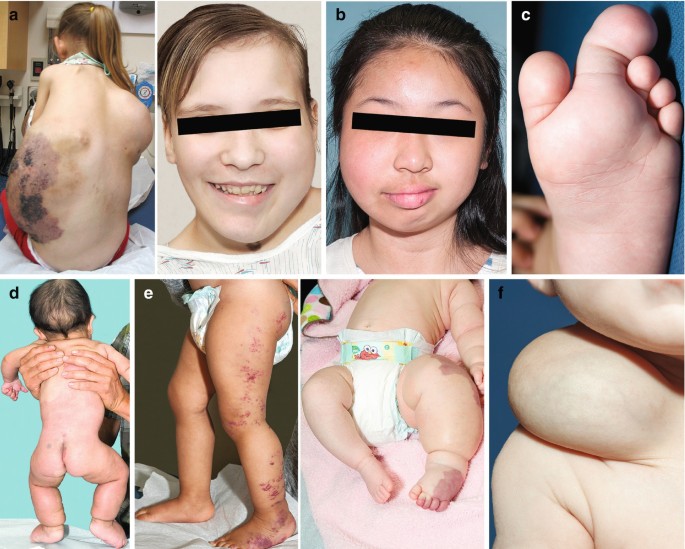PIK3CA-related overgrowth spectrum (PROS) comprises a group of rare disorders characterized by somatic mutations in the PIK3CA gene, leading to abnormal tissue growth in multiple organ systems. These disorders exhibit a wide phenotypic spectrum, primarily due to mosaic postzygotic mutations, which result in localized, asymmetric overgrowth affecting various body parts.

Understanding the Genetic Basis of PROS
PROS conditions are caused by somatic activating mutations in the PIK3CA gene, which encodes the catalytic subunit p110α of the phosphatidylinositol 3-kinase (PI3K) enzyme. This pathway plays a critical role in cell growth, proliferation, migration, and survival.
Mechanism of Mutation
- Mutations occur after fertilization, resulting in genetic mosaicism
- The PIK3CA/AKT/mTOR pathway becomes hyperactivated
- Leads to unregulated cellular growth and overdevelopment of tissues
Clinical Conditions Included in the PIK3CA-Related Overgrowth Spectrum
PROS is an umbrella term covering several overlapping syndromes, unified by a shared molecular etiology:
1. CLOVES Syndrome
Congenital Lipomatous Overgrowth, Vascular malformations, Epidermal nevi, Spinal/skeletal anomalies
- Present at birth
- Overgrowth of fat and muscle tissue
- Complex vascular malformations
2. Klippel-Trénaunay Syndrome (KTS)
- Capillary, venous, and lymphatic malformations
- Limb overgrowth, typically unilateral
- Associated with deep vein anomalies
3. Fibroadipose Hyperplasia/Overgrowth (FAO)
- Localized soft tissue hypertrophy, especially adipose tissue
- Occurs in early childhood
- May involve muscles, nerves, and bones
4. Megalencephaly-Capillary Malformation (MCAP)
- Enlarged brain size (megalencephaly)
- Capillary malformations on skin
- Neurological involvement: developmental delay, epilepsy
5. Hemimegalencephaly (HMEG)
- Asymmetric enlargement of one cerebral hemisphere
- Intractable seizures
- Often diagnosed prenatally or in infancy
Key Clinical Features of PROS
| Feature | Description |
|---|---|
| Segmental Overgrowth | Unilateral or localized tissue hypertrophy |
| Vascular Malformations | Capillary, venous, and lymphatic abnormalities |
| Skeletal Abnormalities | Scoliosis, limb length discrepancy |
| Epidermal Nevi | Raised skin lesions following Blaschko’s lines |
| Neurological Symptoms | Seizures, intellectual disability (in MCAP/HMEG) |
| Disfigurement and Pain | Due to overgrowth or vascular congestion |
Diagnosis of PIK3CA-Related Overgrowth Spectrum
Accurate diagnosis of PROS requires a combination of clinical evaluation and molecular testing.
Clinical Assessment
- Comprehensive physical examination for segmental overgrowth
- Imaging (MRI, CT) to assess internal tissue involvement
- Vascular studies to identify malformations
Molecular Diagnostics
- Tissue biopsy from affected areas preferred over blood due to mosaicism
- Next-generation sequencing (NGS) for low-level PIK3CA mutations
- Droplet digital PCR (ddPCR): High sensitivity, used for detecting mutations as low as 1% variant allele frequency
Differential Diagnosis
PROS must be distinguished from other overgrowth and vascular anomaly syndromes:
- Proteus syndrome (AKT1 mutation)
- PTEN hamartoma tumor syndrome (PHTS)
- Neurofibromatosis type 1
- Isolated macrodactyly (non-syndromic)
Therapeutic Approaches for PROS Syndromes
Currently, there is no definitive cure. Treatment aims to control symptoms, improve function, and manage disfigurement.
Pharmacological Interventions
mTOR Inhibitors
- Sirolimus (Rapamycin): Reduces vascular and lymphatic proliferation
- Limited by systemic side effects
PI3K Inhibitors
- Alpelisib: First-in-class oral PI3Kα-specific inhibitor
- Shows promising results in reducing overgrowth and vascular anomalies
- Used under compassionate or off-label basis
- Common side effects: hyperglycemia, diarrhea, rash
Surgical Management
- Debulking surgeries for significant tissue overgrowth
- Vascular anomaly resection or embolization
- Orthopedic corrections for limb length discrepancies
Supportive Care
- Physical and occupational therapy
- Pain management
- Psychological counseling for body image and emotional support
Long-Term Prognosis and Monitoring
The clinical course of PROS varies depending on the mutation burden and tissues affected.
- Progressive nature: Overgrowth tends to increase with age
- Surveillance imaging: Regular monitoring for vascular changes, organ involvement
- Interdisciplinary approach: Involves genetics, dermatology, surgery, neurology, and pediatrics
Research and Emerging Therapies
Ongoing clinical trials and experimental therapies are targeting the PI3K-AKT-mTOR axis with increasing specificity.
- Low-dose targeted therapies to reduce adverse effects
- Gene-editing and RNA interference (RNAi) under exploration
- Patient-derived cell models being used for personalized drug testing
PIK3CA-related overgrowth spectrum encompasses a heterogeneous group of disorders unified by their underlying genetic mutation and characterized by progressive tissue overgrowth and vascular anomalies. Early and precise diagnosis, combined with emerging targeted therapies, offers new hope for affected individuals. A multidisciplinary, patient-centered approach remains the cornerstone for managing both the functional and psychosocial burden of this lifelong condition.